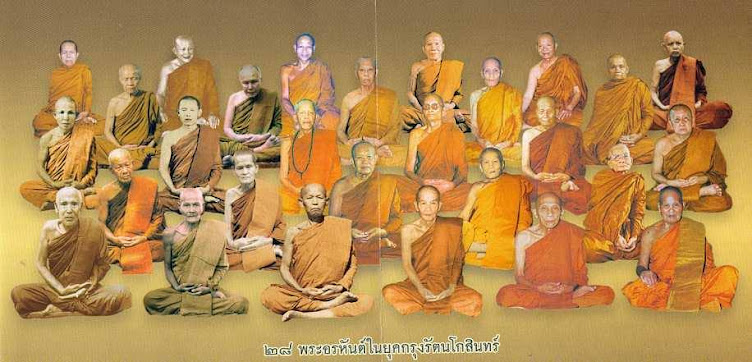DHAMMAYUT AMULET
(The Thai Forest Tradition Amulets)
Ajarn Mun Bhuridatto & His Disciples
The Kammantthana meditation tradition originally grew out of the Dhammayut reform movement founded by Mongkut in the 1820s as an attempt to raise the bar of for what was perceived as the "lax" Buddhist practice of the regional Buddhist traditions at the time. Mongkut's reforms were originally focued on scriptural study of the earliest extant Buddhist texts, revival of the dhutanga ascetic practices and close adherence to the Buddhist Monastic Code (Pali" Vinaya). However, the Dhammayut began to have an increasing emphasis on meditation as the 19th century progressed. During this time,a newly ordained Ajarn Mun Bhuridatto went to stay with Ajarn Sao Kantasilo who was then abbot of a small meditation-oriented monastery on the outskirts of Ubon Ractchathani, a province in the predominantly Lao speaking cultural region of North East Thailand known as "Issan".
Prince Mongkut was a bhikkhu (religious name:Vajiranano) for 27 years (1824-1851)
Dhammayut Emblem
Dhammayutttika Nikaya began in 1833 as a reform movement led by Prince Mongkut (later King Rama 1V)
Ajarn Mun learned from Ajarn Sao in the mate 19th century where he studied amidst the growing meditation culture in Isan's Dhammayut monasteries as a result of Mongkut's reforms a half-century earlier. Wandering the rural frontier of North East Thailand with Ajarn Sao in rigorous ascetic practices (Pali:dhuntanga; Thai: Tudong). Ajarn Mun traveled abroad to neighbouring regions for a time, hoping to reach levels of meditative adeptness known as the noble attainments (Pali: Ariya-Phala) which culminate in the experience of Nibbana (Nirvana) - the final goal of a Theravada Buddhist practitioner.
AJARN SAO KANTASILO
AJARN MUN BHURIDATTO
After more than two decades of intense meditation and ascetic practice, Ajarn Mun would return to Ubon Ratchathani in 1915 claiming to have found the noble attainments. Words spread in the region and monks came to study from Ajarn Mun, wishing to put his claims to test, though the assertions that he found the noble attainments were not universally received at the time - families were divded over whether or not Ajarn Mun had attained sainthood (ariya-phala).
A Group of Dhutanga (Tudong Monks) in the 20th century, Thailand
During this Mongkut's successor Chulalongkorn (Rama V of Siam) had consolidated power in Bangkok and implemented a wave of educational reforms which emphasized the role of the Thai clergy as educators. Dhammayut monks -which included Ajarn Mun and Ajarn Sao and their students were drafted to teach a new monastic curriculum that had been infused with Western principles in an effort to prevent the enroachment of Christian missionaries, and to prevent Thailand from being colonized by a Western Empire. Thailand would successfully prevent colonization; however, Ajarn Mun and Ajarn Sao's students would continue to evade authorities' attempts to assign them to monasteries and prevent them from practicing in the forest.
KING CHULALONGKORN (RAMA V OF SIAM)
Begining in the 1950s though, the tradition would gain respect among the urbanities in Bangkok , and receive widespread acceptance amongst the Thai Sangha. Many of the Arjans were nationally venerated by Thai Buddhists, who regarded them as Arahants. Because of their reputations, the Arjans have become the subject of a cultural fixation on sacralized objects believed among lay followers to offer supernatural protection. This cultural fixation was referred as a cult of amulets , "a traditional preoccupation now reaching the pitch of fetishistic obsession"
During this time, the tradition found a significant in the West, particularly amongst the students of Ajarn Chah Subhatto, a forest teacher who studied with a group of monks in the Mahanikai Sect - the other of Thailand's two monastic orders alongside the Dhammayut - many of whom remained loyal to their Mahanikai pedigree in spite of their interest in Ajarn Mun's teachings.
However, in the final decades of the 20th century, the tradition experienced a crisis when the majority of Thailand's rainforests were clered and cut. Because of this, the Forest Tradition in the early 21st century Thailand has been characterized by a struggle to preserve the remaining forested lands in Thailand for Buddhist practice.
DHAMMAYUT AMULET BOOK (INSIDE ONE OF THE PAGES)










